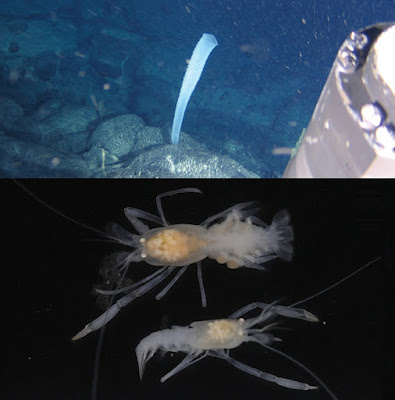 |
| Spongicoloides weijiaensis
Xu, Zhou & Wang, 2017
|
Abstract
A new species of the deep-sea spongicolid genus Spongicoloides Hansen, 1908 is described and illustrated based on material from the northwestern Pacific. Spongicoloides weijiaensis sp. n. was found inside a hexactinellid sponge, Euplectella sp., sampled by the Chinese manned submersible “Jiaolong” at depths of 2279 m near the Weijia Guyot, in the Magellan Seamount Chain. The new species can be distinguished from all congeneric species by several morphological features, involving gill formula, spination of the carapace, antennal scale, third pereiopod, telson and uropod, posteroventral teeth of the pleura, and dactyli of the fourth and fifth pereiopods. An identification key to the Pacific species of Spongicoloides is provided.
Keywords: Hexactinellida, Magellan Seamount Chain, Spongicoloides, Weijia Guyot
Family Spongicolidae Schram, 1986
Genus Spongicoloides Hansen, 1908
Spongicoloides weijiaensis sp. n.
Holotype: ovigerous female, cl 11.1 mm, near Weijia Guyot, Magellan Seamount Chain, North West Pacific, depth: 2279 m, associated with hexactinellid sponge, coll. team of “Jiaolong” submersible, 1 May 2016, sample 37I-JL106-1, SRSIO16050001.
Paratype: male, cl 9.3 mm, same collection data as for holotype, sample 37I-JL106-2, SRSIO16050002.
Diagnosis: Rostrum nearly horizontal, reaching to distal margin of basal article of antennular peduncle; rostral base triangular in dorsal view, each ventrolateral ridge armed with a minute spine. Carapace with distinct cervical groove; anterolateral margin with branchiostegal and pterygostomial spines, and several spinules situated posterior to them; postorbital region armed with one short longitudinal row of spinules; groups of similar spinules also present on posterior portion of cervical groove and rostrum. Second to fourth pleura each with one articular knob; first to third pleura broadly rounded and fourth to sixth pleura each with several posteroventral teeth. Telson quadrangular, with two conspicuous dorsolateral carinae each bearing 7–10 posteriorly directed spines. Eye devoid of dark pigment; eyestalk armed with minute spines. Lateral margin of antennal scale slightly concave, armed with 10–12 spines. Fixed finger of third pereiopod without row of small teeth on distoventral margin; ischium of third pereiopod with one row of 2–4 small teeth on flexor margin. Dactyli of fourth and fifth pereiopods biunguiculate primarily, bearing several much smaller accessory teeth arising from bases of ventral and dorsal ungues.
Etymology: The specific name, weijiaensis, refers to the type locality, the Weijia Guyot, part of the Magellan Seamount Chain in the northwestern Pacific.
Peng Xu, Yadong Zhou and Chunsheng Wang. 2017. A New Species of Deep-Sea Sponge-Associated Shrimp from the North-West Pacific (Decapoda, Stenopodidea, Spongicolidae). ZooKeys. 685; 1-14 DOI: 10.3897/zookeys.685.11341



